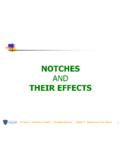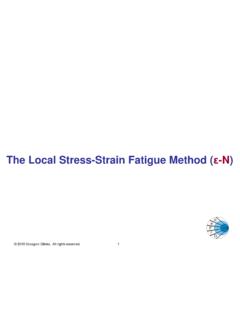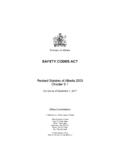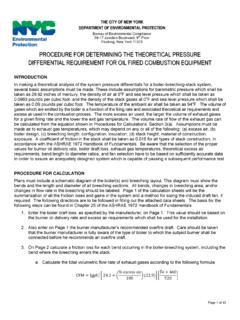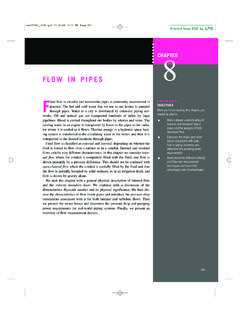Transcription of Fatigue Design Methods
1 Ali Fatemi -University of Toledo All Rights Reserved chapter 2 Fatigue Design Methods1 chapter 2 Fatigue Design METHODSAli Fatemi -University of Toledo All Rights Reserved chapter 2 Fatigue Design Methods2 Fatigue Design Methods STRATEGIES IN Fatigue Design Fatigue Design CRITERIA ANALYSIS AND TESTING PROBABILISTIC Design AND RELIABILITY DIGITAL PROTOTYPING IN-SERVICE INSPECTION AND ACQUISITION OF RELEVANT EXPERIENCEAli Fatemi -University of Toledo All Rights Reserved chapter 2 Fatigue Design Methods3 Fatigue Design Flow ChartAli Fatemi -University of Toledo All Rights Reserved chapter 2 Fatigue Design Methods4 STRATEGIES IN Fatigue DESIGNFour Fatigue life models exist:1.
2 Nominalstress-life (S-N)method First formulated in the 1850s to 1870s. Uses nominal stresses and relates these to local Fatigue strengths for notched and unnotched Localstrain-life ( -N)method First formulated in the 1960s. Local strain at a notch is related to smooth specimen strain-controlled Fatigue behavior. Analytical models can be used to determine local strains from global or nominal stresses or Fatemi -University of Toledo All Rights Reserved chapter 2 Fatigue Design Methods5 STRATEGIES IN Fatigue Design (CONT D)3. Fatigue crack growth (da/dN- K) method First formulated in the 1960s.
3 Requires the use of fracture mechanicsto obtain the number of cycles to grow a crack from a given length to another length and/or to fracture. This model can be considered a total Fatigue life model when used in conjunction with existing initial crack size following Fatemi -University of Toledo All Rights Reserved chapter 2 Fatigue Design Methods6 STRATEGIES IN Fatigue Design (CONT D)4. Two-stage methodby combining 2 and 3 to incorporate both Fatigue crack nucleation and growth. Incorporates the local -N model to obtain the life to the formation of a small macrocrack and then integration of the Fatigue crack growth rate equation for the remaining life.
4 The two lives are added together to obtain the total Fatigue life. All four of these Fatigue life models are covered in this course/book and each have areas of best Fatemi -University of Toledo All Rights Reserved chapter 2 Fatigue Design Methods7 Fatigue Design CRITERIA Criteria for Fatigue Design have evolved from infinite life to damage tolerance. Each of the successively developed criteria still has its place, depending on the application. The criteria for Fatigue Design include usage of the four Fatigue life models (S-N, -N, da/dN- K, two-stage method). These criteria are: Infinite-LifeDesign Safe-LifeDesign Fail-SafeDesign Damage-TolerantDesignAli Fatemi -University of Toledo All Rights Reserved chapter 2 Fatigue Design Methods8 Fatigue Design CRITERIA (CONT D) Infinite-Life Design Unlimited safety is the oldest criterion.
5 It requires local stresses or strains to be essentially elastic and safely below the Fatigue limit. For parts subjected to many millions of cycles, like engine valve springs, this is still a good Design criterion. This criterion may not be economical ( global competitiveness) or practical ( excessive weight of aircraft) in many Design Fatemi -University of Toledo All Rights Reserved chapter 2 Fatigue Design Methods9 Fatigue Design CRITERIA (CONT D) Safe-Life Design The practice of designing for a finite life is known as "safe-life" Design . It is used in many industries, for instance automotive industry, in pressure vessel Design , and in jet engine Design .
6 The calculations may be based on stress-life, strain-life, or crack growth relations. Ball bearings and roller bearings are examples of safe-life Design . The safe life must include a margin for the scatter of Fatigue results and for other unknown factors. The margin for safety in safe-life Design may be taken in terms of life, in terms of load, or by specifying that both margins must be satisfied, as in the ASME Boiler and Pressure Vessel Fatemi -University of Toledo All Rights Reserved chapter 2 Fatigue Design Methods10 Fatigue Design CRITERIA (CONT D) Fail-Safe Design Fail-safe Design requires that if one part fails, the system does not fail.
7 Fail-safe Design recognizes that Fatigue cracks may occur and structures are arranged so that cracks will not lead to failure of the structure before they are detected and repaired. Multiple load paths, load transfer between members, crack stoppers built at intervals into the structure, and inspection are some of the means used to achieve fail-safe Fatemi -University of Toledo All Rights Reserved chapter 2 Fatigue Design Methods11 Fatigue Design CRITERIA (CONT D) Damage-Tolerant Design This philosophy is a refinement of the fail-safe philosophy. It assumes that cracks will exist, caused either by processing or by Fatigue , and uses fracture mechanics analyses and tests to check whether such cracks will grow large enough to produce failures before they are detected by periodic inspection.
8 Three key items are needed for successful damage-tolerant Design : residual strength, Fatigue crack growth behavior, and crack detection involving nondestructive Fatemi -University of Toledo All Rights Reserved chapter 2 Fatigue Design Methods12 Fatigue Design CRITERIA (CONT D) Residual strengthis the strength at any instant in the presence of a crack. With no cracks, this could be the ultimate tensile strength or yield strength depending upon failure criteria chosen. As a crack forms and grows under cyclic loading, the residual strength decreases. Crack detection methodsusing different non-destructive inspection techniques have been developed.
9 Inspection periods must be laid out such that as the crack grows, the applied stresses remain below the residual strength. This philosophy looks for materials with slow crack growth and high fracture toughness. Damage-tolerant Design has been required by the Air Fatemi -University of Toledo All Rights Reserved chapter 2 Fatigue Design Methods13 Fatigue Design CRITERIA (CONT D) In pressure vessel Design leak before burst is an expression of damage-tolerant philosophy. Retirement for cause(extended service life) is a special situation requiring damage-tolerant Fatemi -University of Toledo All Rights Reserved chapter 2 Fatigue Design Methods14 ANALYSIS AND TESTING Analysis and testing are both key aspects of Fatigue Design .
10 A more complete and correct analysis involving iteration and optimization can provide prototypes that are closer to the final product and thus require less testing. Insufficient or incorrect analysis may result in too much dependence upon testing and re-testing creating both time and cost Fatemi -University of Toledo All Rights Reserved chapter 2 Fatigue Design Methods15 ANALYSIS AND TESTING (CONTINUED) Complete computer programs are available for taking a product from an input such as a road profile, or a strain or load spectrum, to a final calculated Fatigue life. However, even the best analysis should not necessarily be the final product Design , particularly with safety critical products.



